By Pedro Nuno Ferreira
Introduction
I already wrote about this subject, but I decided to formalize my writings into an actual article for publication in hopes that it is better explained and thus helps others to avoid mistakes that can have devastating consequences. This is not meant to cause alarm and fear, so please do not throw out that beautiful critter you coveted from the LFS and finally brought home to your reef system because you now realize that it may be worse than Godzilla or the devil himself. There are solutions for such cases and you will surely find them here at Manhattan Reefs or in your local forum/club.
This article is meant to inform, especially the beginners and the unknowing. It is also not an exhaustive compilation of all sea critters that are potentially dangerous, (be it to the reef keeper, to the system, or both), but a comprehensive description of several available critters in the trade that could potentially be introduced into a reef tank without knowing it.
Pseudocolochirus sp. and Paracucumaria sp. – Sea Apple
This critter has a striking appearance, especially to the beginner, and it is also usually not expensive to buy. However, it can and will be very expensive to keep.
Pseudocolochirus spp (species axiologus,tricolor, or violaceus) and Paracacumariaspp (species tricolor, deridderae or hyndmanii) are usually sold under the name of Sea Apple, and can be very poisonous animals to the entire reef!!!
The Sea Apple is a filter feeder that requires a considerable amount of particulate food, phytoplankton and zooplankton to thrive, which it collects with its feeding red arms positioned around the mouth opening while attached to a wall or rock or any other surface that provides adhesion surface to its red or yellow tube feet. Seen peacefully collecting the passing particles of food in the water column, it is quite beautiful and exquisite to see, yet do not let yourselves be fooled by this vividly colored peaceful looking critter. Under its beauty and exotic appearance, this animal has a very powerful poison–Holothurin– which it can release into the water column. It will do this for many reasons: if it is under stress, if it is starving, if it has been attacked by other animals, if it is injured, if it spawns, or even if it has reached the end of its lifetime and is dying.
Please do not think that you will be able to react promptly and perform water changes to remove the poison and save the other animals, because you cannot. The poison is so powerful and fast acting that it will beat any of your attempts. A friend of mine thought he could prevent this, and despite the many warnings we gave him, he learned the hard way. It took 30 minutes to kill all of the life in the entire tank and he was helpless witnessing it.
Still, if you really are determined to keep one of these reef dangerous jewels, then do it in a species tank, where it can live peacefully and get special attention. If something wrong happens, it will be confined to that species tank where it lives alone or with some more members of its species.
Besides sea apples, there are several other animals that can produce and release Holothurin. Those called sea cucumbers are among these, and like the sea apples they belong to the Holothuroids. Sea cucumbers are often suggested as good scavengers, which in fact they are, and many hobbyists do keep them without any incidents. Though the poison released by sea cucumbers is not as concentrated as the sea apples, several species of sea cucumbers sold in the trade are able to produce and release Holothurin as a mechanism of defense. This event is often announced by an evisceration of internal organs called the Cuvieran tubules or Cuvieran organs, after which Holothurin is released. If you have one of these animals and witness such an event, you should remove the eviscerated organs and perform water changes as well as intense skimming and use activated carbon. This action, although not a guarantee, has proved to be of good help to minimize losses.
Asthenosoma sp. – Fire Urchin
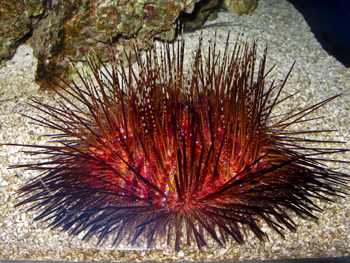
Fire Urchins – (c) J.C. Delbeek. Photo by J.C. Delbeek. Courtesy of the California Academy of Sciences.
Asthenosoma spp urchins (species varium or ijimai) are very conspicuous as they exhibit vibrant and very attractive color patterns. Like many other sea critters, vibrant colors can be a warning of potential danger and nature uses this coloration to warn predators. In this case, the fire urchin is capable of inflicting very painful puncture wounds with the venom-tipped spines. Between the long fragile spines are found comb like groups of shorter spines which have bulbous poison sacs just below the tips. In some species the venom sacs are blue while in others they can be white. As long as the urchin is not touched it is harmless. Accidents usually occur when handling the urchin or while performing maintenance operations in tank, in which case the urchin can be touched inadvertently. If the spines pierce the skin, you will feel an immediate and intense pain which increases in intensity over the following few hours, accompanied by local swelling.
If you really want to keep these urchins then you should also use anti-puncture gloves every time you perform maintenance operations in your tank or handle the urchin.
Toxopneustes sp. – Flower urchins
Toxopneustes sp. urchins (roseus or pileoleus) are as beautiful as they are deadly, so they represent a great threat to the aquarist. The very conspicuous and soft looking surface of this urchin is covered with very attractive flower shaped structures that are approximately 0.25 in. (6mm) across. These beautiful structures are modified spines designated by pedicellaria. Each pedicillaria is equipped with a stalk supporting three jaws with sharp curved teeth that have a basal gland with venom. When they puncture the skin they inject a very powerful venom which according to Cook islands Bishop Museum causes severe pain and muscular paralysis that may last some 6 hours. According to the same source, death from the venom is unknown, but the pain can lead to accidental drowning when diving. At home the effects can vary and the age and health of the aquarist probably also plays a significant role.
I strongly discourage keeping this urchin. In some countries or states, the possession of such animals is not allowed. If by reading this article you realize you have one, please always use anti-puncture thick gloves when working in the tank and you should warn your close relatives, close hobbyist friends, and especially your physician about the fact that you keep one of these, so that if anything goes wrong people may assist you better and more accurately.
Phyllidia varicosa – Fish Killing nudibranch
Phyllidia varicosa is a very conspicuous species of nudibranch that feeds on sponges and often starves in the aquarium by lack of access to them. They are specialized feeders and not any sponge species will do. It is a very poisonous animal and this is due to the specialized diet of sponges, from which it incorporates the toxins which it then uses as a defense mechanism against predators. It announces its poisonous nature through its rich conspicuous pattern, like many other nudibranchs. While living it produces a powerful toxin that it uses in the slime that covers its body. At sea an unwary predator will release it as soon as it tastes the slime and this should end the incident, but in a closed system, the predator or other inhabitants have nowhere to go and they may be poisoned following an incident. Your reef will certainly be poisoned when the animal dies because it either starved to death, or simply because its natural short life span has ended.
Phyllidia varicosa is possibly the worst, but in general all nudibranchs are potentially dangerous. They all are very colorful and conspicuous like the ones from the genusChromodoris, like Chromodoris luterosea or from Genus Nembrotha, like Nembrotha cristata. This makes them almost irresistible to photograph and to keep.Dendrodoris sp. feeds on sponges which are their source of toxins. They modify these toxins to render them even more toxic and when they die they may release these toxins to the water column, and this in a closed system may wipe out the entire system.
Unless you are very experienced and have both the possibility of providing the exact food source in the adequate amount as well as space to house this animal in a single species tank, I suggest you do not keep any of these creatures.
Hapalochlaena sp. – Blue Ring Octopus
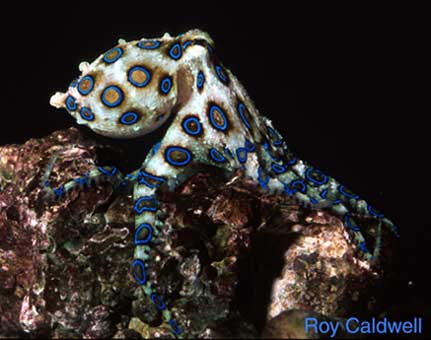
Male (left) and female (right) blue ring octopuses.
Photos by Roy Caldwell, University of California, Berkeley.
When the octopus has its tentacles fully extended it is not much bigger than the opened hand of an adult man, but it is deadly enough to kill ten adults. Maculotoxin is the name of its venom and subsequent studies demonstrated that it is a form of Tetrodotoxin (TTX) (such as the one of puffers and boxfish). It lies in the saliva produced by one of the two glands that the octopus possesses, which it uses for defense against predators. The other gland produces a toxin harmless to humans, which it uses for hunting prey. The Blue ring octopus is rather shy and non aggressive, but if disturbed it can bite through a wet suit and inject you with the neuromuscular paralyzing venom mentioned above. It is an extremely powerful venom which blocks the sodium channels leading to motor paralysis and respiratory failure. The heart and brain continue to function as TTX as no direct effect on these, but the lack of oxygen caused by the lung paralysis will cause death. The bite is described by some sources as rather painless and by others as painful. Whichever it is, the victim may remain still with dilated pupils. Some victims report being conscious but unable to respond, unable to breathe without artificial breathing assistance, and unable to speak or move. No antidote is known and the possible treatment consists of heart massage and artificial respiration until the venom has been eliminated. This should occur some 24 hours after the incident took place. The victim may then recover completely with no side effects unless there was brain damage due to anoxia.
The blue rings are in fact a warning signal and are not always visible, but when the octopus shows them, it means that it is willing to be deadly. Knowledge in CPR – Cardiopulmonary resuscitation techniques – is a must and should be known by the close relatives and reef hobbyist friends of someone that decided to keep one of these animals. This said, it is better to see these octopuses in an institution that has the means and trained personnel to keep them. If you dive and happen to dive in their natural habitat, then just photograph them without touching them and wear a very thick diving suit and gloves. If you are a beach goer in such places, just watch them in a tide pool but do not touch them.
Octopus are intriguing and very intelligent critters that catch the eye as soon as they are visible. They are masters of escaping and can go through incredibly narrow openings. They can even learn tricks and memorize them. Having so many interesting attributes makes them irresistible to many people that want to keep them. These animals require a lot to be in good health and even so most species do not last long as their natural life span is about 3 years. Octopuses need superlative water parameters or they will die. They do not tolerate nitrates and low oxygenation. They are messy eaters and need a lot of live food, (and a significant number of fishes and inverts living in the tank with it, will sooner or later become food), so in consequence they produce a lot of urine and detritus that will contaminate heavily the water in which they live, so powerful skimming is a must among other heavy duty filtration techniques. Cuttlefish and squids are also very much prized and have similar behavior as Octopuses. Like them, they also have short life spans and do require superlative water parameters to be in good health.
Conus sp. – Conus snails
Snails of the genus Conus are so designated because of the shape of their often very beautiful shell that looks like a cone. In fact the shells of these snails are so beautiful that they are very much coveted by shell collectors worldwide, so if you search the internet for conus snails, you are likely to find many sites dedicated to their identification, which helps a lot when one does need to identify a given specimen.
Conus snails are one of the critters that may enter your system with live rock and not necessarily a impulse purchase at the LFS. Conus snails are predators by nature and thus are divided in three groups of feeding habits:
Those that feed on worms – The largest group of these three
Those that feed on other snails – The second largest group of these three
Those that feed on fishes – The smallest group of the three and the one that has the most dangerous species to Humans.
Conus snails are slow by nature, so in order to compensate for that fact they are equipped with a very powerful venom which enables them to paralyze and kill their victims on the spot. They are equipped with a tooth that looks like an harpoon and injects the venom into the body of the prey. The venom is so powerful that the prey is instantly paralyzed.
There are numerous potentially dangerous species for humans, but for this article I will only describe one species, Conus geographus, popularly known as the Cigarette snail.
Known to science as Conus geographus, it is a quite large snail. There is no harm in observing it, be it in the tide pools or inside a tank, however picking it up is a mistake that can be very bad. At tide pools, some people want to have more than a look, so they make the mistake of collecting it. They put it inside one of their pockets or simply put it in their hands … a mistake that they discover when they feel a sting in the leg or hand, perhaps like a bee sting, but the consequences in the case of Conus geographus can be fatal. In fact, the name Cigarette Snail is nothing more than dark humor based of the average time it takes for the venom to kill a person, which is about the time it takes to smoke a cigarette…the last one. A lot more can be said about these snails, but for the main purpose of this article I will suggest for you not to keep these animals, even if it is in a species tank. There is no anti-venom known!
Zoanthus, Protopalythoa, Palythoa, Parazoanthus sp. – Zoanthids – limu-make-o-Hana – Sea Weed of Death
Very popular, very easy to keep, available in a wide variety of colors and sizes, “limu-make-o-Hana”, which translates to Seaweed of death (you can read the story here), is none other than the very much liked and kept zoanthids. Zoanthids produce a very powerful venom in their mucus called palytoxin. It is one of the most toxic poisons in the world. Limu-make-o-Hana has recently demonstrated its power in a “gentle” manner to two MR members which will probably never forget to wear gloves when dealing with zoanthids. (More about palytoxin on Manhattan Reefs.) Do keep zoanthids, but do not forget to handle them with gloves.
Conclusion
It is obvious that a lot more could be said. For instance, TTX (tetradoxin) is produced by far many more animals that we usually know about, and this is related to the fact that this venom is produced by a group of bacteria which lives in a mutualistic association with several different animals. The same goes for palytoxin which is not exclusively produced by zoanthids. Still these subjects exceed the scope and purpose of this article, which is meant above all to inform and help people to avoid devastating consequences.
Cheers
Pedro Nuno
Vila Nova de Gaia – Portugal



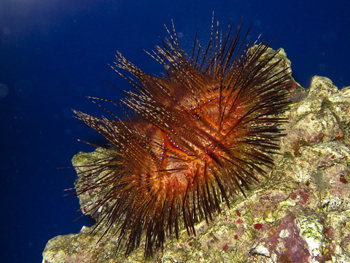
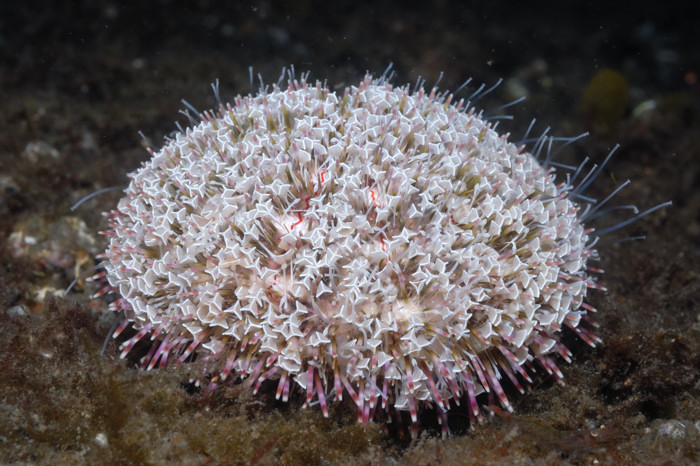


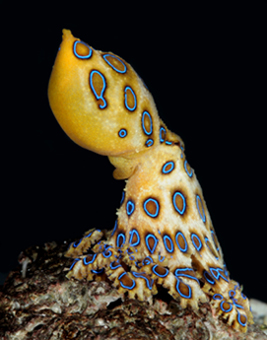
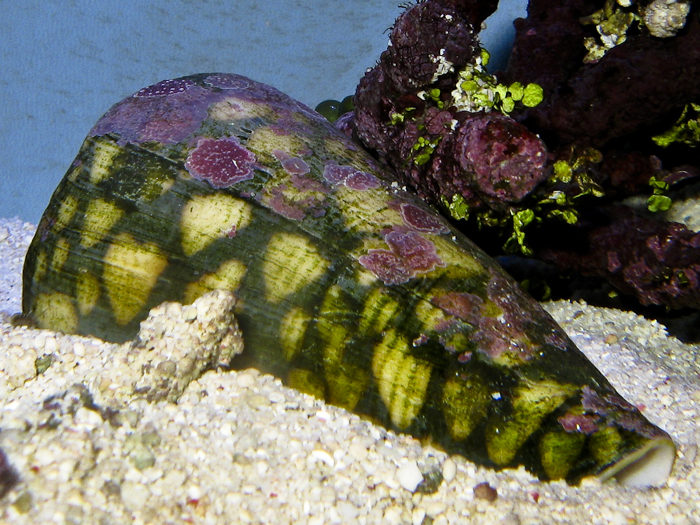
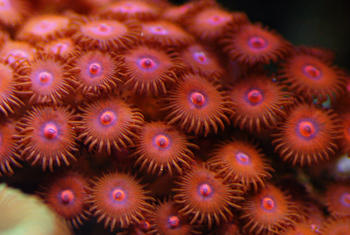
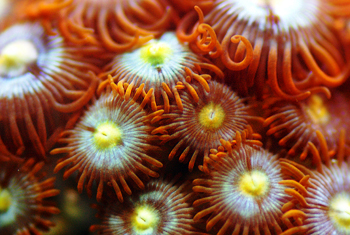
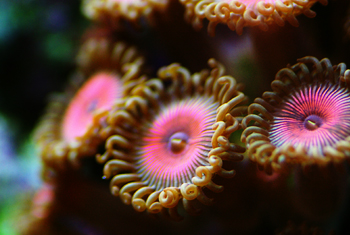
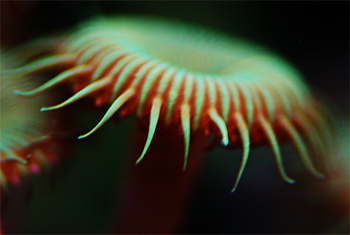

0 Comments